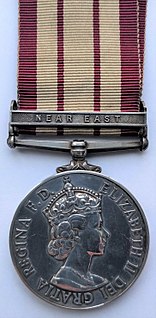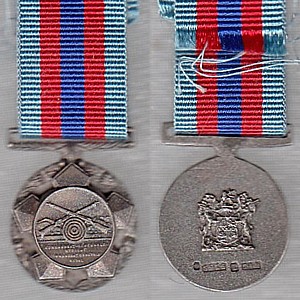
The 1914 Star, colloquially known as the Mons Star, is a British World War I campaign medal for service in France or Belgium between 5 August and 22 November 1914.

The Decoration for Officers of the Royal Naval Volunteer Reserve, post-nominal letters VD until c. 1947 and VRD thereafter, was instituted in 1908. It could be awarded to part-time commissioned officers in the United Kingdom's Royal Naval Volunteer Reserve after twenty years of service as efficient and thoroughly capable officers. The decoration was a Naval version of the Volunteer Officers' Decoration and its successor, the Territorial Decoration.

The Naval General Service Medal was instituted in 1915 to recognise service by the Royal Navy and Royal Marines in minor campaigns that would not otherwise earn a specific campaign medal. The Army/Air Force equivalent was the General Service Medal (1918). Both these medals were replaced by the General Service Medal in 1962.

The Efficiency Medal was instituted in 1930 for award to part-time warrant officers, non-commissioned officers and men after twelve years of efficient service on the active list of the Militia or the Territorial Army of the United Kingdom, or of the other Auxiliary Military Forces throughout the British Empire. At the same time a clasp was instituted for award to holders of the medal upon completion of further periods of six years of efficient service.

The Meritorious Service Medal (MSM) is a British medal awarded to sergeants and warrant officers of the British armed forces for long and meritorious service. From 1916 to 1928, eligibility was extended to cover both valuable services by selected other ranks irrespective of length of service, and for gallantry not in the face of the enemy.
The Queen's Medal for Champion Shot is a Canadian medal instituted on 28 August 1991 to honour one member each of the Canadian Armed Forces (CF) Regular Force and either the CF Reserve Force or the Royal Canadian Mounted Police (RCMP) who obtained the highest aggregate score in stages one and two of the Queen's Medal Competition. It replaced its British counterpart, the Queen's Medal for Champion Shots in the Military Forces, after 1992. In respect of the Canadian Regular Force, the British medal could only be won by Army members, whereas the Canadian medal can be won by members of the Canadian Forces.

The Medal for Long Service and Good Conduct (Military) is a medal awarded to regular members of the armed forces. It was instituted by King George V in 1930 and replaced the Army Long Service and Good Conduct Medal as well as the Permanent Forces of the Empire Beyond the Seas Medal. The medal was originally awarded to Regular Army warrant officers, non-commissioned officers and men of the UK Armed Forces. It also had a number of territorial versions for the Permanent Forces of the British Dominions. The eligibility criteria were relaxed in 1947 to also allow the award of the medal to officers who had served a minimum period in the ranks before being commissioned. Since 2016, the eligibility was widened to include officers who had never served in the ranks, and so the medal can now be awarded to all regular members of the British Army who meet the required length of service.

The Efficiency Medal was instituted in 1930 for award to part-time warrant officers, non-commissioned officers and men after twelve years of efficient service on the active list of the Citizen Force of the Union of South Africa. At the same time, a clasp was instituted for award to holders of the medal upon completion of further periods of six years of efficient service. The medal superseded the Colonial Auxiliary Forces Long Service Medal.

The Royal Naval Volunteer Reserve Long Service and Good Conduct Medal, initially designated the Royal Naval Volunteer Reserve Long Service Medal, was instituted in 1908. It could be awarded to part-time ratings in the United Kingdom's Royal Naval Volunteer Reserve after twelve years of service and good conduct. The medal was a Naval version of the Volunteer Long Service Medal and its successor, the Territorial Force Efficiency Medal.

The Permanent Forces of the Empire Beyond the Seas Medal is a long service and good conduct medal, instituted for award to other ranks of the Permanent Forces of the Dominions and Colonies of the British Empire. The medal, also known as the Permanent Overseas Forces Long Service and Good Conduct Medal, was established in 1910 as a single common award to supersede the several local versions of the Army Long Service and Good Conduct Medal which were being awarded by the various territories.

The Commandant General's Medal is a military marksmanship medal which was created by the Commandant General of the South African Defence Force in 1962 and formally instituted by the State President in 1965. It was awarded to the champion shot of the annual South African Defence Force Shooting Championships from 1962 to 1975. The year the award was earned, is shown on a bar which is worn on the ribbon. The award could be won multiple times, with each subsequent award indicated by an additional bar.

The Army Long Service and Good Conduct Medal was instituted by King William IV in 1830. The medal remained in use for 100 years, until it was replaced by the Medal for Long Service and Good Conduct (Military) in 1930. During that time the reverse of the medal remained virtually unchanged, while the design of the obverse was altered during the reigns of Queen Victoria, King Edward VII and King George V.

In May 1895, Queen Victoria authorised Colonial governments to adopt various British military medals and to award them to their local military forces. The Colony of Natal introduced this system in August 1895 and, in 1897, instituted the Army Long Service and Good Conduct Medal (Natal).

The Naval Long Service and Good Conduct Medal (1830) of the United Kingdom was introduced in 1830 and ratified by King William IV in 1831. It could only be awarded to selected Navy ratings after altogether 21 years of service and good conduct. The medal remained in use until 1847, when it was replaced by the Naval Long Service and Good Conduct Medal (1848).

The Naval Long Service and Good Conduct Medal (1848) is a long service medal awarded to regular members of Her Majesty's Naval Service. It was instituted by Queen Victoria to replace the Naval Long Service and Good Conduct Medal (1830), and could be awarded to other ranks and men serving in the Royal Navy and Royal Marines. Since 2016, after a number of changes in eligibility, all regular members of the Royal Navy and Royal Marines who have completed fifteen years of reckonable service can be awarded the medal.

The Colonial Auxiliary Forces Long Service Medal was instituted by Queen Victoria in 1899 as a military long service award for part-time members of all ranks in any of the organized military forces of the British Colonies, Dependencies and Protectorates throughout the British Empire. The medal gradually superseded the Volunteer Long Service Medal for India and the Colonies in all these territories, with the exception of the Isle of Man, Bermuda and the Indian Empire.

The Queen's Medal for Champion Shots of the New Zealand Naval Forces was retrospectively instituted for New Zealand in 1958, the first medal having already been awarded in 1955. The medal is a Naval counterpart of the Queen's Medal for Champion Shots in the Military Forces and the Queen's Medal for Champion Shots of the Air Forces. One medal can be awarded annually to the champion shot of a small-arms marksmanship competition held by the Royal New Zealand Navy.

The Queen's Medal for Champion Shots of the Air Forces was instituted in 1953, as an Air Force version of the Queen's Medal for Champion Shots in the Military Forces. One medal each can be awarded to the champion shot of annual small arms marksmanship competitions held by the Air Forces of the United Kingdom and those member countries of the British Commonwealth whose Governments desire to take part in the grant of the award.

The Queen's Medal for Champion Shots of the Royal Navy and Royal Marines was instituted in 1966. The medal is a Naval counterpart of the Queen's Medal for Champion Shots in the Military Forces and the Queen's Medal for Champion Shots of the Air Forces and is identical to the Queen's Medal for Champion Shots of the New Zealand Naval Forces that had been instituted in 1958. One medal can be awarded annually to the champion shot of a small-arms marksmanship competition, held by the Royal Navy and Royal Marines.

The Medal for the Best Shot in the British Army, Infantry, was instituted by Queen Victoria in 1869 and was awarded annually from 1870 to 1882 to the best shot of the Infantry of the British Army, including the Royal Engineers and the Colonial Corps.




















